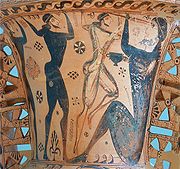
Polyphemos Painter
Encyclopedia

Athens
Athens , is the capital and largest city of Greece. Athens dominates the Attica region and is one of the world's oldest cities, as its recorded history spans around 3,400 years. Classical Athens was a powerful city-state...
or on Aegina
Aegina
Aegina is one of the Saronic Islands of Greece in the Saronic Gulf, from Athens. Tradition derives the name from Aegina, the mother of Aeacus, who was born in and ruled the island. During ancient times, Aegina was a rival to Athens, the great sea power of the era.-Municipality:The municipality...
. He is considered an innovator in Attic
Attica
Attica is a historical region of Greece, containing Athens, the current capital of Greece. The historical region is centered on the Attic peninsula, which projects into the Aegean Sea...
art, since he introduced several mythological themes. His works are dated to between 670 and 650 BC. It is likely that he was not only a vase painter, but also the potter of the vessels bearing his works.
The Polyphemus Painter was probably a pupil of the Mesogeia Painter
Mesogeia Painter
The Mesogeia Painter, also Mesogaia Painter, was an Early Proto-Attic vase painter.His conventional name is derived from his name vases, several hydriai decorated by him and discovered in the Mesogeia. This Early Proto-Attic artist was a contemporary of the Analatos Painter, active in the first...
. His conventional name refers to his name vase
Name vase
In classical archaeology, a name vase is a specific "vase" whose painter's name is unknown but whose workshop style has been identified. The painter is conventionally named after the selected "name vase" that embodies his characteristic style, or for one of its distinctive painted subjects, or for...
, a neck amphora found at Eleusis, which had served as the funerary vase for a child. It is sometimes known as the Eleusis Amphora. The painting on the neck, depicting the blinding of Polyphemus
Polyphemus
Polyphemus is the gigantic one-eyed son of Poseidon and Thoosa in Greek mythology, one of the Cyclopes. His name means "much spoken of" or "famous". Polyphemus plays a pivotal role in Homer's Odyssey.-In Homer's Odyssey:...
, and that on the belly, showing Perseus
Perseus
Perseus ,Perseos and Perseas are not used in English. the legendary founder of Mycenae and of the Perseid dynasty of Danaans there, was the first of the mythic heroes of Greek mythology whose exploits in defeating various archaic monsters provided the founding myths of the Twelve Olympians...
and the gorgon
Gorgon
In Greek mythology, the Gorgon was a terrifying female creature. The name derives from the Greek word gorgós, which means "dreadful." While descriptions of Gorgons vary across Greek literature, the term commonly refers to any of three sisters who had hair of living, venomous snakes, and a...
s, belong to the earliest identifiable depictions of scenes from Greek mythology
Greek mythology
Greek mythology is the body of myths and legends belonging to the ancient Greeks, concerning their gods and heroes, the nature of the world, and the origins and significance of their own cult and ritual practices. They were a part of religion in ancient Greece...
. The Antikensammlung
Antikensammlung Berlin
The Antikensammlung Berlin is one of the most important collections of classical art in the world, now held in the Altes Museum and Pergamon Museum in Berlin, Germany. It contains thousands of ancient archaeological artefacts from the ancient Greek, Roman, Etruscan and Cypriot civilizations...
at Berlin
Berlin
Berlin is the capital city of Germany and is one of the 16 states of Germany. With a population of 3.45 million people, Berlin is Germany's largest city. It is the second most populous city proper and the seventh most populous urban area in the European Union...
once contained a clay stand, lost during World War II, known as the Menelas Stand, by the Polyphemus Painter. It depicts a group of men holding spears. The word Menelas, the Doric dialect
Doric dialect
Doric dialect can refer to:*The Doric dialect of Greek*The Doric dialect of Scots...
form of Menelaus
Menelaus
Menelaus may refer to;*Menelaus, one of the two most known Atrides, a king of Sparta and son of Atreus and Aerope*Menelaus on the Moon, named after Menelaus of Alexandria.*Menelaus , brother of Ptolemy I Soter...
, is written next to one of the figures, forming the oldest known inscription in Attic art. The Doric dialect is unusual in Attica, but spoken on Aegina. Since all figures wear identical clothing, they may represent a chorus
Greek chorus
A Greek chorus is a homogenous, non-individualised group of performers in the plays of classical Greece, who comment with a collective voice on the dramatic action....
. Thus, it has been hypothesised that the inscription could also act as a kind of "speech bubble", as the lines of a chorus - in Greek drama, the chorus conventionally spoke Doric. However, this interpretation has been accepted by some and contested by other scholars, leaving it uncertain.
Before the identity of the painters of the Berlin and Eleusis pieces had been established, the Menelas Stand was sometimes ascribed to a hypothetical Menelas Painter.
Literature
- Thomas Mannack in Griechische Vasenmalerei. Eine Einführung, Theiss, Stuttgart 2002, p. 96–97, ISBN 3-8062-1743-2

